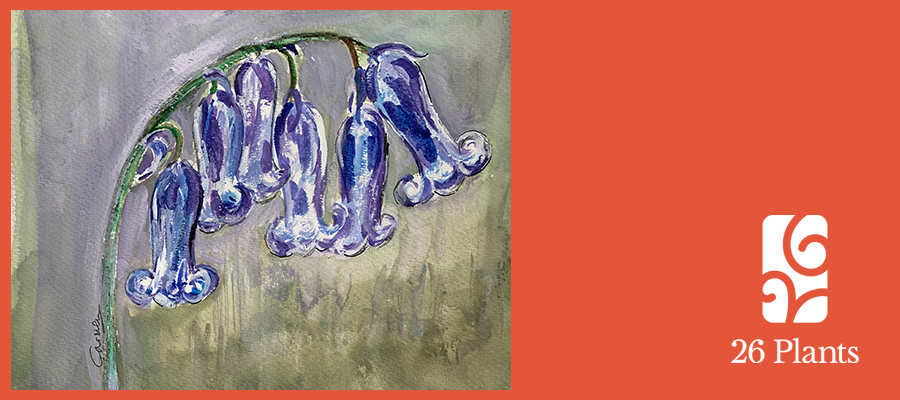Common Bluebell
Hyacinthoides non-scripta
Carmen Lavin
‘A blue lake!’ you gasp. The vision stretches out in front of you.
Stay still.
Breathe in the energy of those shining bells,
thousands upon thousands, vivid violet-blue,
hanging from arching stems,
curling petals high
with song and welcome into Spring.
Keep tight hold of this moment
in the dappling shade of woodlands wakening into leaf,
watching bumblebees and butterflies drink in the creamy nectar.
Guard this place. It is our heritage.
Don’t let the deep blue
pale into stocky clusters of upright hybrid flowers. Or die beneath felled trees or trampling feet.
Smiles light your face. ‘A blue lake!’
The hyacinthoides non-scripta carries its own myth. Hyacinthus, the hero of a tale from ancient Greece, being taught by the god Apollo how to throw a discus, is accidentally knocked down to the ground by him and dies. Apollo, grief-stricken and weeping at the place marked by the blood of Hyacinthus, watches a flower appear and grow. As petals form, Apollo’s falling tears spell out the letters AIAI on them which signify ‘alas’.
From these legendary origins, Karl Linnaeus, in his 1753 work of botanical classifications, Species Plantarum, gave the genus of the common bluebell the name hyacinthoides, meaning ‘like a hyacinth’, non-scripta, ‘unlettered’, distinguishing it from the blood and tears of the story.
Bluebells bring their vibrant spectacle as Spring arrives each year. In their masses they shoot up in the moving, partial shade of new leaves of deciduous trees in the growing sunlight. The common bluebells need these trees. Their deep blue, slim, long, bouncing bells hang, one by one, from one side of each nodding stem, curling over into themselves. This is what makes them distinctive.
Native to western Europe, almost half of all the bluebells on earth are here in England, but even here the common bluebell may not be as common as we’d like to think. They’re picked, flattened under wandering feet or uprooted by diggers in their ancient habitats. And of great concern, there is the rival Spanish bluebell, hyacinthoides hispanica.
Spanish bluebells, introduced by Victorians, are paler. Their leaves are broader, and their squatter, wider bell-shapes, barely turning at the tips, cluster round their straight and upright stems right to the tops. They grow in open spaces without need of shade. And they hybridise vigorously with the hyacinthoides non-scripta, taking them over.
This is why the common bluebell has been protected in the UK by law since 1981 under the Wildlife and Countryside Act. Yet it continues to be in danger.
The hyacinthoides non-scripta has been part of England’s heritage for centuries. It has had special uses. Its sticky sap bound pages along spines of books and glued feathers onto arrow shafts. Its bulbs were crushed in times gone by to produce a kind of starch to stiffen ruffs worn around collars. Medical research indicates how, in future, it may give us help in treating cancer.
Meanwhile the hyacinthoides non-scripta is vital for Spring insects, vital, too, for our Spring minds and souls.
Image by Carmen Lavin.

